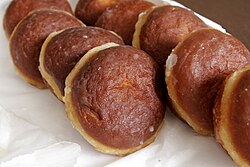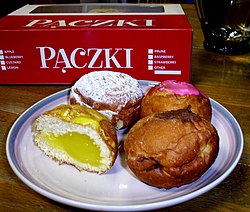Pączki
This article needs additional citations for verification. (February 2008) |

Pączki (Polish pronunciation [ˈpɔnt͡ʂki]) are pastries traditional to Polish cuisine (the word pączek is sometimes translated as doughnut). Pączki is the plural form of the Polish word pączek [ˈpɔnt͡ʂɛk], though many English speakers use paczki as singular and paczkis as plural. In English, the common pronunciations /[invalid input: 'pɔ̃tʃki']/ or PONCH-kee[needs IPA][1] imitate the Polish pronunciation, but some speakers pronounce the word POONCH-kee, PUNCH-kee, or PANCH-kee[needs IPA]. The Polish word "pączek" itself is a diminutive of pąk ("plant bud").[1]
Typical pączki

A pączek is a deep-fried piece of dough shaped into a flattened sphere and filled with confiture or other sweet filling. Pączki are usually covered with powdered sugar, icing or bits of dried orange zest. A small amount of grain alcohol (traditionally, Spiritus) is added to the dough before cooking; as it evaporates, it prevents the absorption of oil deep into the dough.[2]
Although they look like bismarcks or jelly doughnuts, pączki are made from especially rich dough containing eggs, fats, sugar and sometimes milk. They feature a variety of fruit and creme fillings and can be glazed, or covered with granulated or powdered sugar. Powidła (stewed plum jam) and wild rose hip jam[2][3] are traditional fillings, but many others are used as well, including strawberry, Bavarian cream, blueberry, custard, raspberry and apple.[4]
Pączki have been known in Poland at least since the Middle Ages. Jędrzej Kitowicz has described that during the reign of August III, under the influence of French cooks who came to Poland, pączki dough was improved, so that pączki became lighter, spongier, and more resilient.
Pączki Day
In Poland, pączki are eaten especially on Fat Thursday (the last Thursday before Lent). Many Polish Americans celebrate Pączki Day on Fat Tuesday (the day before Ash Wednesday). Traditionally, the reason for making pączki was to use up all the lard, sugar, eggs and fruit in the house, because they were forbidden to be consumed due to Catholic fasting practices during Lent.
In the large Polish community of Chicago, and other large cities across the Midwest, Pączki Day is celebrated annually by immigrants and locals alike. In Buffalo, Toledo, Cleveland, Detroit, Grand Rapids, Milwaukee, South Bend, and Windsor, Pączki Day is more commonly celebrated on Fat Tuesday instead of Fat Thursday. Chicago celebrates the festival on both Fat Thursday and Fat Tuesday, due to its sizable Polish population.
In Hamtramck, Michigan, an enclave of Detroit, there is an annual Pączki Day (Shrove Tuesday) Parade,[4] which has gained a devoted following. In the Greater Cleveland area, it is wide spread through out the region, that many bakeries have people that will wait in lines for pączki on Pączki Day. [citation needed] The Pączki Day celebrations in some areas are even larger than many celebrations for St. Patrick's Day. [citation needed]
Pączki in America

These pastries have become popular in the United States as a result of Polish immigrants and marketing by the bakery industry.
Pączki variations worldwide
In several other countries, pączki appear in the local cuisines.
- Argentina, it's called Berlinesas (Spanish for "Berliner") or "Bolas de Fraile" (Monk's Balls)
- Brazil, it's called Sonho - Portuguese for "dream"
- Canada, Blak's Bakery in Windsor, Ontario have been making Paczki since 1918. Nana's Bakery in Windsor Ontario has a low fat version called the Loczki.[5]
- Chile, it's called berlín - Spanish for "berliner"
- Czech Republic, they are called "koblihy", the Czech word for doughnuts (the toroidal ring doughnut being practically unknown until the Velvet Revolution, fall of Communism and opening of the borders)
- German and Danish, they are called Berliner. In Austria and Bavaria they are called Krapfen
- Hungary, it is called fánk
- Iran, they are called "Pi-rash-ki" and are very popular, especially among children
- Italy they are called bomboloni
- Lithuanian cuisine, they're called spurgos
- Mexico, it's called Bola de Berlín, Spanish for "Berlin ball"
- Netherlands, they are called Berliner bollen, similar to Oliebollen
- Portuguese tradition, a similar confection called the malasada is made during Fat Tuesday. In Hawaii, where Portuguese immigrants worked the sugarcane and pineapple plantations, malasadas are a popular breakfast or dessert item that can be purchased at countless malasada bakeries.
- Romania, they are called gogoşi and are a very popular snack, especially during the summer.
- Russian cuisine, the word "pączki" transformed phonetically into ponchiki (Russian: пончики, plural form of пончик, ponchik) or pyshki (Russian: пышки, especially in St. Petersburg). Ponchiki are a very popular sweet doughnut, with many fast and simple recipes available in Russian cookbooks for making them at home as a breakfast or coffee pastry.[6]
- Slovenia, they are known as krofi
- Turkey, they are called ponçik
- Ukrainian cuisine, they are called пампушки, pampushky
See also
References
- ^ a b pączki Dictionary.com. Retrieved November 23, 2009.
- ^ a b Strybel, Robert and Strybel, Maria. Polish Heritage Cookery, Hippocrene Books (2005). p. 270.
- ^ Paczki? Hard to say, culinary Lenten treat made by nuns. Catholic News Service. Retrieved November 23, 2009.
- ^ a b Pączki Day in Hamtramck
- ^ Nana's Bakery Blog, (2010)
- ^ Recipes for Russian and other ponchiki Template:Ru icon.
External links
- Pączki Day PSA, an account of Detroit area Pączki Day traditions in 2008

